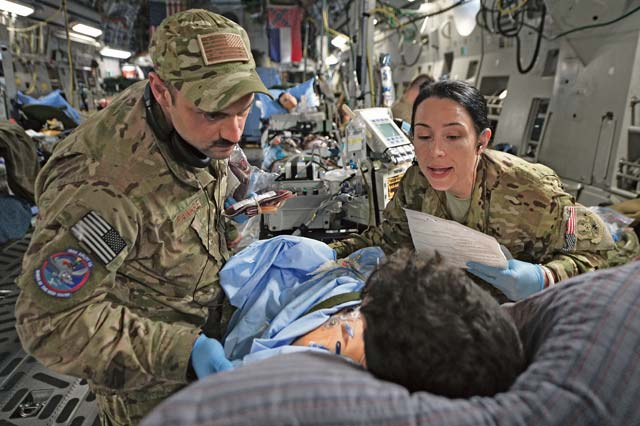
Editor’s note: This is the fourth in a six-part series about medical response capabilities for deployed service members from start to finish and the various milestones for care and transportation of combat-wounded troops throughout Afghanistan. To read Part I, click here. To read Part II, click here. To read Part III, click here.
Three critically injured patients need immediate transfer to a medical facility outside of Afghanistan. One was shot in the head, the other has missing limbs and the last has an open abdominal wound. Without a mobile intensive care unit, these patients will not make the flight out.
For members of the 455th Expeditionary Aeromedical Evacuation Squadron Critical Care Air Transport Team, this is go-time.
A CCATT crew consists of a physician, an intensive care nurse and a respiratory therapist. Together
they can turn a regular medical transport aircraft into a flying intensive care unit, making it possible to move severely injured or gravely ill service members by air to Landstuhl Regional Medical Center.
Starting with the aeromedical evacuation of the patients from forward operating bases, to treating them at the Contingency Aeromedical Staging Facility and then transporting them out of the country through a C-17 Globemaster III “Reach” mission to LRMC, moving patients throughout the area of responsibility takes a working team with multiple parts.
At the Craig Joint Theater Hospital on Bagram Airfield, the CCATT crew unplugs the patient from the hospital’s power and respiratory machines and moves them into mobile units that are positioned along with stretchers. Then, with the help of the hospital staff and the CASF crew, the patients are moved to the flightline where an aircraft awaits, already configured for their needs.
Once on the aircraft, each patient is attached to the central air and power supply and prepared for takeoff. Since the majority of the CCATT’s patients are unconscious during the trip, great care is given to monitor their vitals and well-being.
“We make a promise to these men and women that no matter what happens, we will do everything in our power to bring them home,” said Capt. Mario Ramirez, CCATT physician. “Being a part of CCATT is a great honor and allows me to help fulfill that mission.”
While other passengers are getting some rest, the CCATT crew stays constantly on their feet observing the patients and watching for any signs of immediate medical need.
“It’s all about these guys and girls who put their lives on the line for us. The least we can do is give them the most optimum care we can provide,” said Senior Airman Delton McClary, CCATT respiratory therapist. “If we can get them from Afghanistan to Germany with no problems and better than when we received them, then we did our job.”
Every CCATT mission has its own unique challenges and is different than anything that exists in civilian medicine. They are trained to be a medical, surgical and trauma multi-specialty team, all in the back of an aircraft with limited resources.
“I work with an outstanding team, and together we are able to give these troops the same level of care they would get in America’s best intensive care units,” Ramirez said.
Pre-mission planning and good team communication is vital to the execution of CCATT mission. The job cannot be done by just one or two members of the team.
“We have learned to trust each other,” said Capt. Suzanne Morris, CCATT nurse. “During a mission there is a lot going on, and you have to rely on your teammates if you want to succeed.”
Flexibility is also very important when it comes to the CCATT missions. They can be flying to an unexpected location to pick up an unexpected patient or flying a mercy mission to reunite an injured service member with their family.
“Every mission has a particular place in my heart, some with great endings…some not,” McClary said. “But even more importantly, we get the patients to their family, and that’s the feel-good part of my job that I love to do.”
Even though the patients have a far longer journey to go for full medical recovery, they are now out of Afghanistan and at a higher level of care, thanks to the men and women of the 455th Air Expeditionary Wing.







